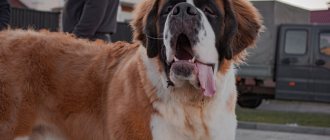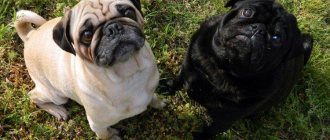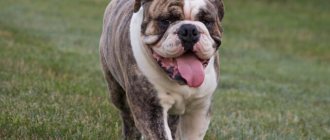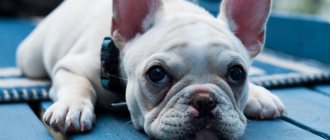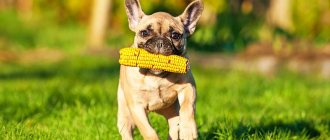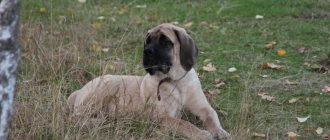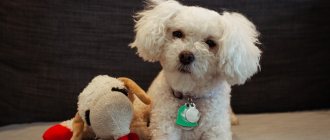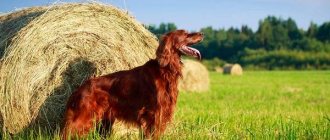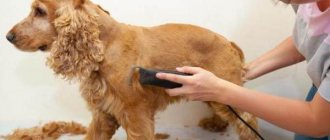Saint Bernard - there is some holiness in his name
Serving people is the privilege of all domestic dogs. Saint Bernard proved himself especially worthy in this field. It all started in the 11th century. In the Alps, on the Mont-Jou mountain pass, the monk and former nobleman Bernard de Menton created a haven for travelers. In the 12th century, the shelter became a monastery. Monk Bernard was canonized, the monastery received the name Saint-Bernard.
Since the time of Alexander the Great, very large dogs have been kept in the Alps. Local residents have long paid attention to their ability to anticipate approaching avalanches and find people buried in snow. The dogs began to accompany monks and travelers going from Italy to Switzerland and back.
By the 17th century, dogs were actively used as rescue dogs. Directed selection work began to be carried out. The breed received the name Saint Bernard . In the 19th century, dogs were credited with numerous rescue feats.
The breed has gained popularity. Breeders began to care about the purity of the species. The dog's appearance is close to modern. The Swiss Stud Book SHSB was created in 1884. The first dogs recorded in the book were St. Bernards.
Saint Bernards are dogs with huge hearts
The Saint Bernard is a dog breed that deserves respect not for its impressive size, but for its kindness and wisdom. The Sen breed was bred quite a long time ago, by mating the Molossian Dane and the Pyrenees, which made it possible to obtain a dog capable of searching and rescuing people.
Saint Bernard puppy
The history of the breed begins in the Swiss Alps, in the monastery of St. Bernard. The monastery was located high in the mountains, and novices often got lost on the road, getting lost among the snow. Even then, the potential for saving human lives was noticed, thanks to which the breed soon spread throughout the world.
Description and features
The Saint Bernard is a very large dog. An adult animal weighs from 60 to 100 or more kg. The height at the withers of a male individual should not be less than 70 cm. In an adult female, this parameter is 65 cm. The maximum height at the withers of a male is 90 cm. The maximum height at the withers of a female is 80 cm. Accepted standards for height and weight may be exceeded. These deviations are not considered a defect if the proportions and naturalness of movements are maintained.
Large dimensions, bulkiness, not very sporty appearance - this is the result of selection. To be convinced of this, just look at what the St. Bernard looked like in a photo taken at the beginning of the last century.
The length of the body is related to the height at the withers, ideally 10 to 9. The withers rise significantly above the general line of the back. The loin is short. The back and chest are wide, the chest is convex.
Saint Bernard is one of the most popular dog breeds that faithfully serves humans
A large head is located on a powerful neck. The skull is wide. Steep descent from forehead to muzzle. Nose is black. The eyes are medium. Together with developed jowls, the face looks smart, expressive, and charismatic.
Wide-set, strong limbs. The thighs are developed and muscular. The paws are wide. The tail is long, heavy, wide at the base. In general, the dog can be described as a large, very powerful, respect-inspiring animal.
History of the breed
For a long time, a dangerous narrow gorge-pass in the harsh Alps (at an altitude of 2469 meters above sea level!) between Switzerland and Italy threatened travelers with death. Bitter frosts, gusty winds, sudden changes in weather, landslides, avalanches, and robbers lay in wait for those who dared to take the short route. In the 11th century, the Augustinian monk Bernard of Menton opened an inn at the disastrous pass, providing travelers with shelter, food and safety.
Subsequently, the monk was canonized, the gorge began to bear his name - the Great St. Bernard Pass.
The classic image of a St. Bernard rescue dog with a keg of brandy around his neck is actually a “duck” invented for tourists. Alcohol is no salvation for a freezing person, so St. Bernard’s dogs warmed travelers with their warmth. Photo: Mirage Lin
To protect and help those in trouble, lost and frozen people, tall, hardy and intelligent dogs were bred and used. It is believed that they originated from peasant guard dogs or from mixing the blood of a Danish bulldog with a Pyrenean or Tibetan mastiff. That's what they were called - Alpine Mastiffs.
The dogs worked in pairs - a male and a female. Having found a lost, weakened and frozen person, the bitch lay down next to him and warmed him, and the male went for help. This science was so imprinted in the genes of the “sacred dogs,” as they were also called, that even now, when they see a person lying down, they try to lift him up.
The owner of the St. Bernard nursery, Jenny Babins, conducted an experiment: she lay down on the ground and remained motionless. The puppies behaved like this: the bitches lay down next to them, and the males began to fuss and look for something. In her opinion, this behavior is a memory of the dogs’ ancestors
From the mid-12th century to the present day, mountain dogs have guarded, protected and saved people. They warned of an avalanche or an earthquake with a characteristic howl, found travelers under the snow, cleared the way, and carried loads. And there was always at least one dog in the kennel with the name Barry - that’s the tradition. Therefore, the name has become a household name - this is how representatives of the breed are often called.
The annals of the monastery contain records of Barry the First, who over the years of his work saved 4 people a year.
Effigy of Barry at the Berne Natural History Museum
His effigy is kept in the Berne Natural History Museum, and there is a monument dedicated to him in France.
Saint Bernards cleared the road after heavy snowfalls in the mountains. It happened like this: the monks released a flock in front of them, and powerful wide-legged dogs easily ripped through the snow surface, leading people behind them. Barry's dogs were harnessed to carts and sleds carrying heavy loads. In Alaska, St. Bernard athletes carried loads weighing several tons!
With the development of technology, heavy St. Bernards were replaced in this position by lighter German Shepherds, but the most famous Alpine kennel of these Molossians is still thriving. On June 2, 1887, the International Canine Congress recognized the Saint Bernard as a Swiss breed, and since then it has been the Swiss national dog.
Few dog breeds can boast of their own museum. In the city of Martigny (Switzerland) there is a “living” museum “Berryland”, essentially a St. Bernard nursery, where visitors can learn more about the history of the breed and communicate with these beautiful animals.
Living Museum of the Berryland Breed. Photo: https://www.fondation-barry.ch
At the beginning of the 19th century, Alpine Mastiffs were brought to England. Since 1882, the breed received the name St. Bernard. And in 1888, the St. Bernard Club opened in America. These dogs continue to help people: giving care and tenderness to the family, decorating the house, or serving where living conditions leave much to be desired - in the cold mountains, on snowy plains or in harsh Alaska.
Character
The Saint Bernard dog is calm, friendly, and not aggressive. Attached to the family. He happily meets acquaintances and even unfamiliar people. He does not show emotions very strongly. A simple wagging of the tail can indicate exuberant delight.
Security functions are performed passively, by demonstrating one's power. In case of a threat to family members, the dog manifests itself as an active protector.
The character of the St. Bernard fully corresponds to its purpose: companion, escort, rescuer. The best character traits appear if the dog is raised from an early age as a member of the family. Raising a dog in an enclosure, away from the team, can lead to unpredictable consequences, including mental disorders in the dog.
The Saint Bernard combines a kind nature with enormous physical strength.
Kinds
Dangerous work and low prevalence led to the fact that at the beginning of the 19th century the number of St. Bernards decreased to a critical level. To restore numbers, two Newfoundland males were brought to the monastery.
As a result of interspecific crossing, a new variety of St. Bernards appeared: long-haired. The hope that a reinforced coat would improve the working qualities of dogs was not justified. The resulting long-haired variety turned out to be of little use for rescue activities.
The line founded by the Newfoundlands was not stopped. On the contrary, the long-haired version of the dog was favorably received by the public and began to spread quickly. This was facilitated by the intelligence, nobility, goodwill and formidable appearance of the four-legged friend. Today two lines are developing in parallel: short-haired and long-haired.
In the middle of the 20th century, several attempts were made to develop new breeds. The result of crossing the St. Bernard with other large dogs was the appearance of the Moscow Watchdog. It is sometimes called the Moscow St. Bernard .
Until the 80s of the 20th century, there was a periodic influx of St. Bernard blood into this breed. Now the purity of the breed line is maintained. The main task set by the breeders was to enhance the guarding qualities of the dog. They achieved this. It is not for nothing that the name of the breed contains the word “guard”.
Shorthaired Saint Bernard
Main characteristics
Switzerland is considered the birthplace of St. Bernards. They appeared in this country in the mid-seventeenth century. They are characterized by an affable and kind disposition, seasoned with courage, loyalty and heroism.
The weight of St. Bernards ranges from 70-100 kilograms, and the height is between 65-90 centimeters. On average, St. Bernards live no more than eleven years.
The color of this breed comes in several shades: golden, orange and brown. Some Saint Bernards may have small black spots, which are in no way considered a sign of marriage.
Representatives of the St. Bernard breed have good mental abilities. They are obedient, disciplined, responsible and attentive.
Saint Bernards cope well with search tasks. And even in the absence of specific teams, they are able to make decisions independently and show ingenuity.
Care and maintenance
Saint Bernard is a luxury that the owner of a spacious living space can afford. Saint Bernard usually appears in the house at the age of one month. Before this, an important stage occurs - choosing a puppy. Color, activity, size are important criteria, and parental data is even more important.
Eating familiar foods, a comfortable place to sleep, and a calm environment in the home will ensure a normal start in life. There is no need to hold the puppy in your arms or take it to bed for a long time. Bad habits learned at an early age are difficult to correct. Effective body thermoregulation in a puppy begins at the age of 3-4 months. Therefore, you have to make sure that it does not settle in a place where there is a possibility of a draft.
Accustoming to one's own place is an essential aspect of early education. At the same time, the puppy should not feel lonely. Constant communication with family members is the key to a healthy psyche, self-confidence, and strong character. The puppy must have toys. Any objects that will not cause injury are suitable for this purpose. There should be no restrictions when moving around the home.
The puppy grows quickly like no other breed . a Saint Bernard gains 50-70 kg. With such rapid growth, a special load falls on skeletal bones and cartilage. Considering this fact, climbing stairs and jumping from heights are contraindicated for a puppy. Until the age of 3 months, you have to carry the puppy outside in your arms. Raising and lowering, he is held by the whole body.
At about 3 months, the first molt occurs, teeth begin to change, and the baby’s own immune system comes into play. Learned habits, both good and bad, are reinforced.
From a very early age you need to take your puppy for walks. You should start with short walks of 10-15 minutes. A desirable component of the first walks should be sunny weather. Walking strengthens the dog's immunity. In addition, the puppy is accustomed to relieving itself outdoors.
The number of walks for a young dog should be at least 4. It is advisable to walk for the longest time in the sun or at least during daylight hours. Walking for a puppy means a lot of movement, carefreeness and communication with the owner. Heavy loads, long runs, jumping and climbing can negatively affect the health of the animal.
Scientists admire the St. Bernard's ability to anticipate a snowstorm 40 minutes before it starts.
A small St. Bernard requires a lot of time from the owner. So much so that sometimes it is useful to divide the care of the animal among all family members. Brushing is an important part of grooming your dog, especially during shedding periods. Technically this is a simple event. Special combs and brushes are used as tools. Short-haired St. Bernards naturally cause less trouble.
Experts do not recommend washing your dog frequently. Twice a year she is subjected to bath procedures: in spring and autumn. The dog is washed in water at a temperature of 40°C according to the full program: soaping, rinsing in the shower, drying with a towel, drying with a hairdryer.
Each walk can end with hygiene procedures. The dog is wiped and cleaned in parts. In winter, the best way to clean wool is snow, in summer - swimming.
No less often than with fur, one has to deal with the eyes. Droopy eyelids are not very good eye protectors from dust. The situation can be corrected by daily wiping the eyes with a textile napkin. Before this, the cloth is moistened with warm water or weak tea.
If we wash our eyes daily, then it is enough to wipe our ears once a week. The technique is simple: a swab is moistened with an antiseptic (for example: boric alcohol) and the auricle is wiped. More complex actions, such as blowing dry boric acid into the ear, should only be done after consulting a veterinarian.
In dogs that often move along asphalt paths, their claws wear down on their own. If this does not happen, you need to take the clippers and trim the overgrown claws. This is done carefully so as not to damage the living part of the claw. The cracked stratum corneum is covered with wax or medical glue.
Dogs' claws and paws are often damaged in winter if the animal has to walk on roads sprinkled with chemicals. In such cases, there is only one way out: put shoes on the dog. You can build simple shoes yourself or purchase ready-made ones.
Teeth are another concern. In the third week of life, the puppy's baby teeth appear. They begin to change at 3 months, and by 11 months the change is completed. Once teeth appear, the dog must become accustomed to having its teeth examined.
Uncomplainingly providing teeth for examination and cleaning will make life easier for the owner and the dog itself. The main factor influencing dental health, as well as that of dogs in general, is nutrition.
Exercise stress
Saint Bernards are a hardy and physically active breed; they are suitable for long walks and active games like agility .
But you shouldn't be overzealous. Due to their large size, St. Bernards are more suitable for walking or slow running and quiet games.
Saint Bernards love to swim
When the St. Bernard puppy is tired enough after a walk and well fed, he can calmly wait for his owner.
But he should leave a few toys so that he has something to occupy himself with.
Even at home, you need to play with animals (especially small ones) so that their activity is directed in a positive direction, while unobtrusively training and explaining the rules of behavior.
St. Bernard puppies require great care when handling.
You can’t lift them by their front legs - you can dislocate their joints, and in general you shouldn’t carry them around often.
If you need to lift your baby, support him under the chest and under the buttocks, and when lowering him back to the floor, make sure that all four paws are on the floor, and only then remove your hands.
A dog that has walked enough and is tired will behave well at home.
A St. Bernard puppy can easily injure ligaments if it jumps from a height greater than its height. Running is better for this breed than jumping.
Nutrition
With the diet of a one-month-old puppy, everything is simple: the new owner must feed him the same food that was provided to him by the St. Bernard nursery or breeder. Simple rules that a dog must unconditionally follow: feeding occurs at the same time, food can only be obtained in its own bowl.
A piece of food can be served by the owner by hand. This is the only exception to the feeding rules. It allows you to establish closer contact between the owner and the animal and promotes success in learning and training.
A difficult to achieve, but very important taboo regarding nutrition is not to pick up food from the floor or ground. Mastering this prohibition will save the dog’s health or even life. In the first months of life, the dog is fed 5-6 times a day. The number of feedings per year is reduced to 3. At the age of two, the dog can be fed twice a day.
The amount of food is determined in accordance with the condition and physical activity of the puppy. If the food is not completely eaten, the portions are reduced. If the puppy licks for a long time and does not move away, the portions increase slightly.
The basis of the diet is protein foods. Its best embodiment is raw meat. A one-month-old puppy is required 160-200 g per day. Gradually, meat consumption increases and by the year it can reach up to 0.5 kg.
Meat of various origins is suitable (beef, lamb, horse meat), but it should not be fatty. Offal is an excellent food: lung, heart, udder. Kidneys are a healthy product, but due to the pungent odor, the dog may refuse such food.
Fish is a very significant component of the St. Bernard's diet. It can even completely replace meat. But to satisfy the need for protein, it will require one and a half times more. Usually the fish is cooked briefly.
To improve digestion, the puppy receives fermented milk products from the age of six months. To enhance the mineral and vitamin component, seafood products are often included in the diet. After eating, the dog is given bones. It is desirable that they contain a large amount of cartilage. Calcium is vital for such a large dog.
Reproduction and lifespan
In females, the first heat occurs at 8-9 months. Males are ready for adulthood a month later. But young animals are not allowed to breed. Bitches can be bred at 2 years of age. Males become full-fledged producers at 2.5 years. Otherwise, St. Bernard puppies will be weak.
Animals involved in the production of offspring must be healthy and in good shape. Dogs approaching 8 years of age are generally not allowed to breed.
The male is ready for breeding all year round. He needs to be kept ready for this process all the time: he needs to be fed well, walked a lot, and monitored his health. Before meeting a real contender for mating, a male dog should not feel the presence of current females. The dog may become nervous and burn out. In this case, the real planned mating will fail.
Pregnancy lasts 64 days (from 58 to 66 days). At this time, the dog needs extra attention. Starting from week 3, the volume of food increases. If a large number of puppies are expected, the number of feedings to the expectant mother is increased.
After 55 days from the beginning of pregnancy, a place for whelping is prepared for the dog and given the opportunity to get used to it. Just before the birth, the owner needs to be with the dog more often - this gives peace to the dog.
With children, the St. Bernard behaves the same way as with puppies, protecting and nurturing
Experienced breeders can help during childbirth. If there are no skills in providing obstetric care, it is better to invite a veterinarian. Saint Bernards cannot be called long-livers. 8-10 years is considered the normal life expectancy for these dogs.
Price
Saint Bernards are considered a rare breed. It's not easy to maintain them. Therefore, the price for purebred puppies is high. But even offspring from titled producers may have some defects.
If the existing defect does not interfere with life, but is a serious deviation from the breed standard (for example, an incorrect bite), then the price of a St. Bernard can range from $100 to $500. This is the so-called Pet class.
Many puppies do not deviate from the breed standard. But the experienced eye of an expert sees some imperfections. Such a puppy can cost $500-$1000. This is Breed class. Perfect puppies from all points of view, future champions and future parents of champions are valued at an amount exceeding $1000. This is Show class.
Tips for choosing a puppy
How to choose a puppy if there are not so many kennels breeding St. Bernards, and some of them have fabulous prices? Consulting a dog handler and visiting exhibitions can help in this difficult matter.
- Consultation
. Some breeders offer consultations for an additional fee. Experts explain what healthy St. Bernard puppies should look like and adequately assess their appearance (soft coat, absence of problems with the eyes and musculoskeletal system). Often the buyer is asked to make sure that the parents do not have serious illnesses. For example, if the bitch and the dog did not suffer from dysplasia, then the likelihood of this disease manifesting itself in the puppy is low. - Exhibition
. A good choice would be to visit an exhibition, where you can get to know the breeder and his pet directly, and see how well the animal meets the breed standards.
The cost also depends on the completeness of the package of documents. The puppy must be sold with a puppy certificate, which can later be exchanged for a pedigree, and a veterinary passport.
Training
Training begins with simple walks. Teaching a dog not to play with a leash, not to take food from strangers, not to allow strangers to stroke and caress him is a big victory at the initial stage of training.
Many experts believe that results can only be achieved by affection and redirecting the puppy’s attention. Others are of the opinion that punishment is a natural and acceptable way to internalize prohibitions.
The most important of the prohibiting commands is “fu”. But with any method of bringing the prohibition to the dog’s mind, this command should not be given often. Otherwise it loses its significance. At the age of several months, even an inexperienced trainer is able to teach a dog to follow simple orders: “sit”, “come to me”, “voice” and the like.
Saint Bernards react quickly to other dogs, but never show aggression
Further training usually begins at about one year of age. The dog does not yet lose sensitivity to training and acquires a stable psyche. The dog usually acquires special skills under the guidance of an experienced trainer at the age of 1 to 2 years.
Possible diseases and methods of treating them
In general, the Saint Bernard is a dog in good health. But during the period of growth, that is, up to the age of one year, she is threatened by various diseases of the joints and bones. For example: dysplasia, herniated vertebral discs.
With age, overeating and low physical activity can lead to obesity. As a result - disease of the heart and blood vessels, gastrointestinal tract and other internal organs.
Damage to the nervous system, whether hereditary or viral, can lead to epilepsy. A balanced menu, proper grooming steps, and long walks will keep the dog’s health at a good level. And the owner will be given the friendship of a large and noble creature.
